
The history of military service in the Basque Country is complex. Many have served and died for the hope of independence, while others have fought and lost their lives trying to keep Spain intact. And still more individuals fulfilled their country’s requirements and served Spain or France through military conscription.
France adopted military conscription as a condition of citizenship to boost the military during the French Revolution. In 1905, conscription was set at two years of mandatory service. Length of service changed over time and during war years and ended all together in 2001. King Carlos III of Spain introduced conscription service in 1770. After 230 years, Spain also stopped this military tradition in 2001.
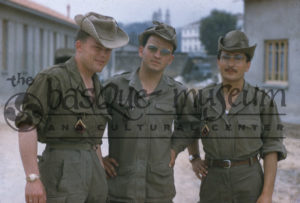
Bernard Igoa, center. Photo shared with BMCC by his son, Pierre Igoa.
Bernard Igoa
Sergeant Bernard Igoa served in the French Army as a part of the French military compulsory tradition in the Genie Militaire (Engineering Corps). In his two years of service, from 1956 to 1958, Bernard was stationed in Germany, Morocco, and fought in the Algerian conflict. He is originally from Urepel, France and has lived in Bakersfield,
California since 1963.
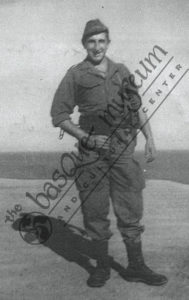
Bertrand Ossinalde
Bertrand Ossinalde served in the French Army from July, 1960, through January 1963. During his time in the Army, Bertrand was deployed to Algeria to fight in the Algerian War. He was awarded a service medal for his involvement in Algeria. Bertrand was honorably discharged on January 20, 1963. He now lives in Fresno, California.
The Spanish Civil War erupted after a military coup d’état, led by General Francisco Franco and part of the Spanish army against the Spanish government. Similarly to the American Civil War, the Spanish Civil War pitted brother against brother, and this was especially true among the Basque people of Spain.
A Basque army, called the Gudaris (fighters), fought for the Spanish government who promised independence for the Basque Country after the war. Others fought for the Requete, a pro-Franco militia group fighting against the Spanish government. Regardless of the politics involved, both sides had individuals fighting for their homeland.
The Spanish Civil War shattered the country, lasting from 1936-1939. Spain, as a country, did not formally participate in World War II. The French, however, found themselves in the heart of the war and many Basques fought under the French flag during this time. The Gernika Battalion is one such example of Basques fighting for the French in WWII. Created in 1944 by the Basque Government, this battalion of Basque men showed the world that they too were against the Nazis.
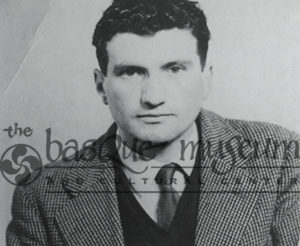 Pierre “Pete” Salla
Pierre “Pete” Salla
Pete Salla was drafted into the French Army and served for three years. He was only supposed to serve 18 months on active duty in Germany. After 18 months, when it was time to go home, he was shipped to North Africa instead. Pete could speak Spanish, French, and German and was often used as an interpreter during his time of service. Pete immigrated to the US in 1959 and settled in Winnemucca, Nevada.
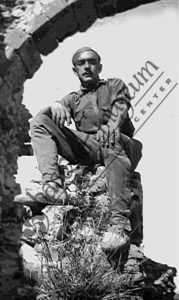
Sabin Landaluce
Sabin Landaluce volunteered to fight for the Republic during the Spanish Civil War when he was 17 years old. When Bilbao fell in 1937, he was taken prisoner by Franco’s regime and held in Logrono and Burgos, Spain, as well as in Morocco, Africa. Sabin was a prisoner of war for seven years. He immigrated to the US in 1952 and settled in Boise, Idaho.
Many, immigrants and citizens alike, served because they were drafted. America began drafting men as early as the American Civil War. Men registered for the draft were selected for service in World War I, World War II, the Korean War, and the Vietnam War. Many Basque immigrants served in these conflicts as a result of being drafted.
While some were forced into military service, others joined or enlisted on their own. Their motives for enlisting varied from one individual to the next. Some gained citizenship after their service, a few while they were deployed, and others were told not expect naturalization because of their service – following the normal process for citizenship even though they fought for the US.
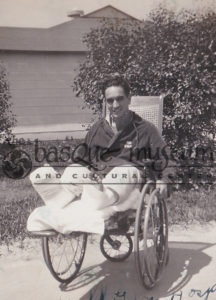
Julian Aramburu
Some fought for a change in their lives, others fought for the pride in the place they now called home. World War II veteran, Julián Aramburu, emigrated from Spain and the Basque Country when he was 16. He was recruited by the US Army in 1942, and while not a citizen at the time, he would say, “if this country is good enough to live in, it is good enough to fight for.” Julián fought valiantly for his new country and was honored with a Silver Star. He suffered injuries that cost him his leg. Upon his return to the US, Julián stayed at the veteran’s hospital for three years and then began a career as a prosthetist, helping others who had lost limbs.
By the time World War II broke out, many of the young Basques in America were first generation born in the US and already had citizenship. For these young men and women, joining military efforts had different motives than the generation before. Pete Cenarrusa was born in Idaho and joined the US Marines in 1942. The pride in his country was evident throughout Pete’s life as a Marine and as an Idaho politician.

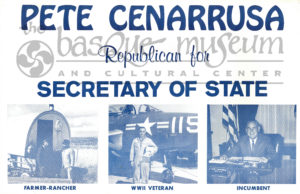
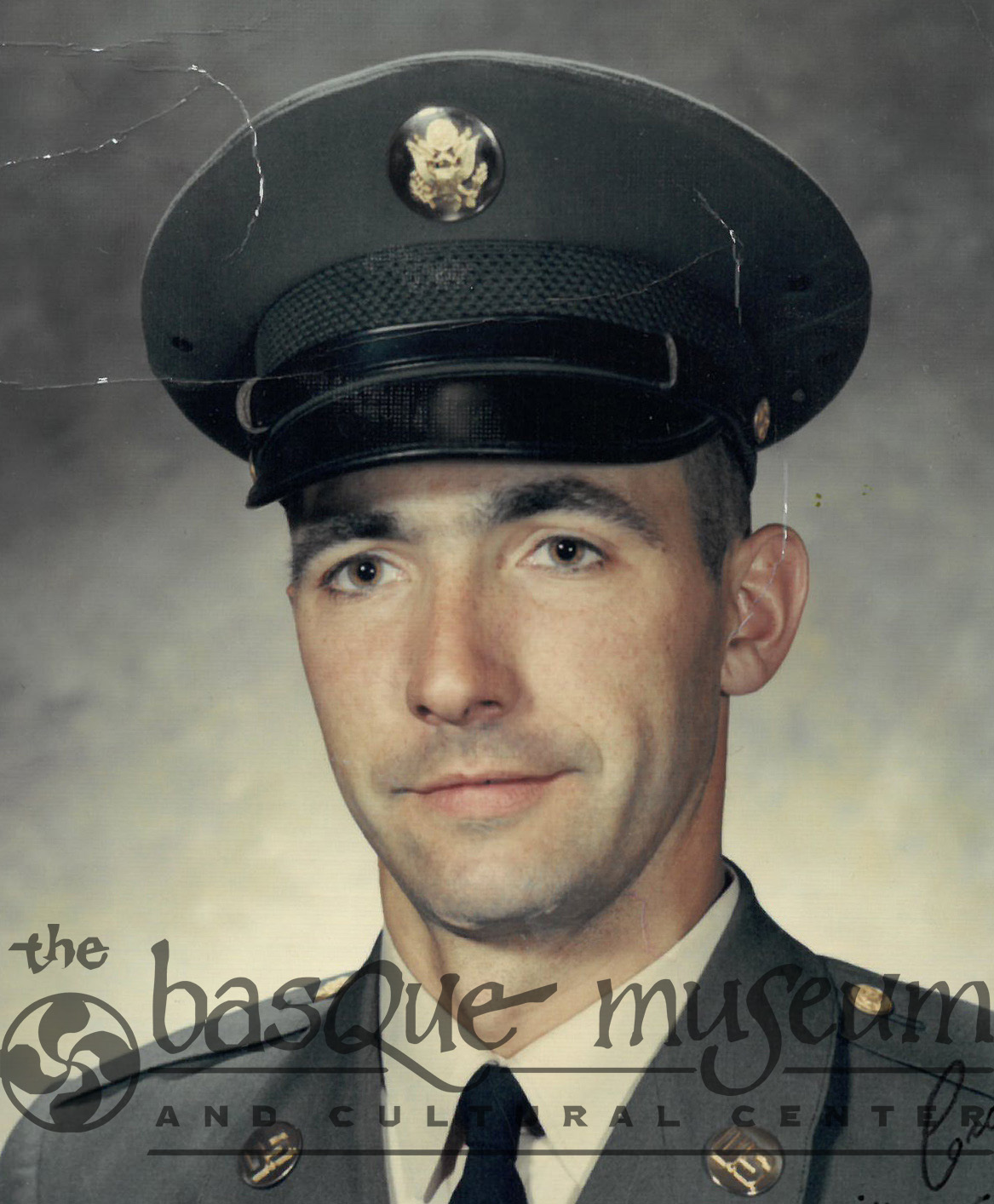
Enrique Goitiandia
Enrique Goitiandia served in the Army during the Vietnam War. He was on active duty from August 8, 1969 to April 17, 1971 serving as a specialist four. While in Vietnam, Enrique was stationed with the 63D Transportation Company from May 16, 1970 to April 16, 1971. Enrique did not receive his citizenship due to his military service, rather he was required to take an exam while in Honolulu, Hawaii while still serving in the Vietnam War. He was released from the Reserves on August 8, 1975.

Julián Lachiondo
Julián Lachiondo was born in Ibarrengelu (Bizkaia) in 1915. He immigrated to the US in 1931 to work as a sheepherder with his father. In 1940, Julián and his friend Benturo Zubizarreta signed up for the peacetime draft. In 1941, they both were called to fill Idaho’s Elmore County draft quota. Julián and Benturo were inducted into the US Army on February 20, 1941, along with fellow Basques, John Subisarreta, John Odiaga, Joe Aldape, and John Anduiza. Julián served in the Army Infantry, Company K, 186th Infantry Regiment, 41st Infantry Division. Serving as staff sergeant and rifle squad leader, Julián spent 33 months overseas in Australia, New Guinea, and Biak. In 1942, Julián filed for naturalization while overseas, and was made a US citizen while in combat in New Guinea. Fifty men were naturalized in a mass ceremony on Biak, including Julián. He was sent home in 1944 after contracting malaria. Julián received the Bronze Star for his service.
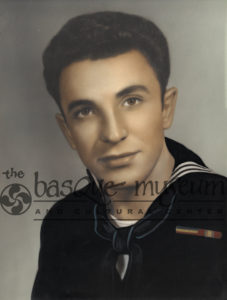 Luis “Louie” Echevarria
Luis “Louie” Echevarria
Luis “Louie” Echevarria immigrated to the US with his mother, brother, and sister in September of 1953. They traveled to Parma, Idaho to begin life in America with Louie’s father who arrived a year before. The children entered high school not knowing any English but quickly learned. In 1957, Louie joined the Navy to show his appreciation for his new country. In the Navy, Louie served as a seaman, BTFN (boiler technician fireman) and received the Good Conduct medal. He was honorably discharged in 1959. Louie became a US citizen a year later in 1960. During his naturalization process, he changed his last name from Malaxechevarria to Echevarria.
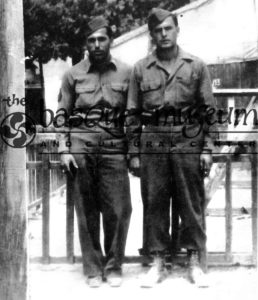 Florencio “Pancho” Aldape
Florencio “Pancho” Aldape
Florencio Nicolas Aldape was born in Durango, Bizkaia, in 1920 and immigrated to the US when he was 14 years old. In America he received the nickname “Pancho.” Though not yet a US citizen, Pancho enlisted in the Army in 1942. He received his citizenship during boot camp at Camp Maxey, in Paris, Texas. During World War II, Pancho worked in the Army Corps of Engineers with assignments in North Africa, Italy, the French Riviera, Normandy, and Germany. He even met some fellow Basques in camps across his travels. Pancho was honorably discharged in 1945. He returned to Idaho and began work in construction. During his life, Pancho considered himself equal parts Basque and American.
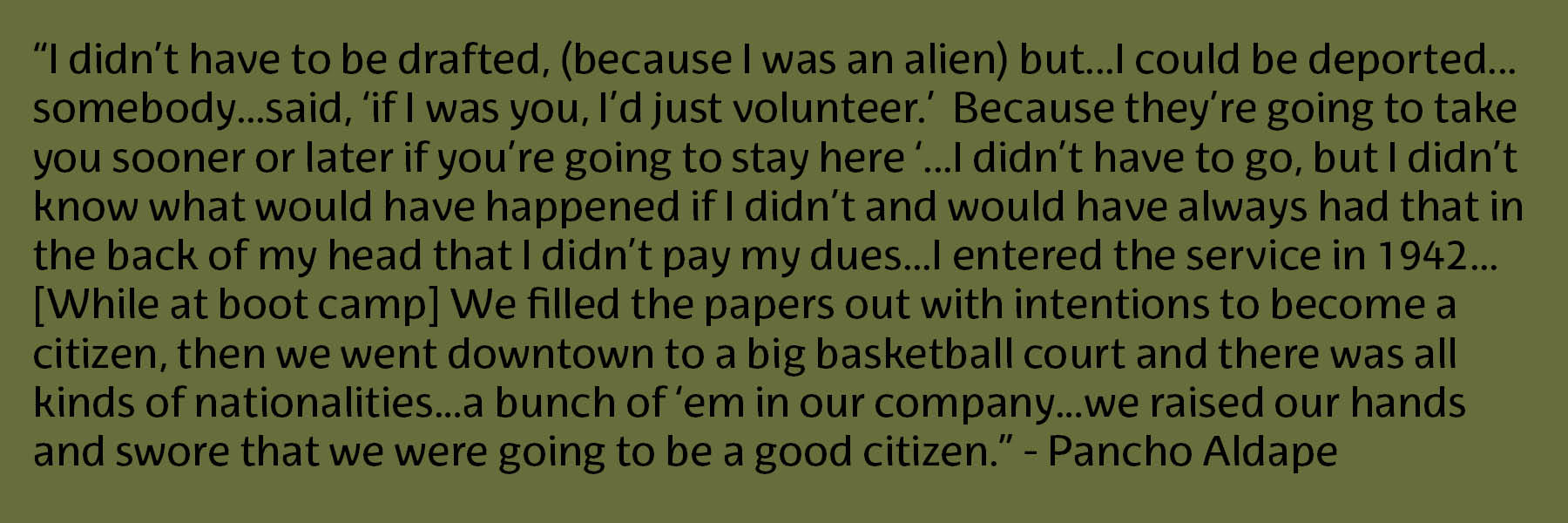
The Selective Service and Training Act (America’s first peacetime draft) was enacted on September 16, 1940. It required that men who had reached their 21st birthday but had not yet reached their 36th birthday to register with local draft boards. Among those initial registrants in Idaho, John Anduiza, John Subisaretta, John Odiaga and Joe Aldape from Ada County and Julián Lachiondo and Benturo Zubizarreta from Elmore County all took their oath of enlistment on February 20, 1941. This group along with other draftees were sent to Fort Douglas, Utah and then assigned to different units. All were U.S. citizens except for Lachiondo who had emigrated to the U.S. in 1931. They left behind jobs in retail grocery, butchering, and sheepherding.
Anduiza would later return to Boise and serve in the Basque Reserve Regiment. The others served in the Pacific theater and saw combat on Guadalcanal, New Guinea and Biak. Joe Aldape was awarded a Silver Star for gallantry in the New Guinea-Salamaua campaign. Julián Lachiondo was awarded a Bronze Star for combat efforts on the island of Biak. He also was given American citizenship through a naturalization service on Biak. Both Aldape and Lachiondo contracted malaria in New Guinea were sent back to the U.S to recuperate.
After the war, the group remained friends and formed several business and social relationships. Lachiondo used his G.I. Bill benefits for on-the-job training in meat cutting under the tutelage of Joe Aldape. All were founding members of Euzkaldunak (the Basque Center) in Boise, Idaho and several served on its Board of Directors.

All the men above took their oath of enlistment on the same day, February 20, 1941. Left to right: Henry Gabiola, Benturo Zubizarreta, John Subisaretta, Julián Lachiondo, Joe Aldape, and John Odiaga. Photo donated by Dave Lachiondo
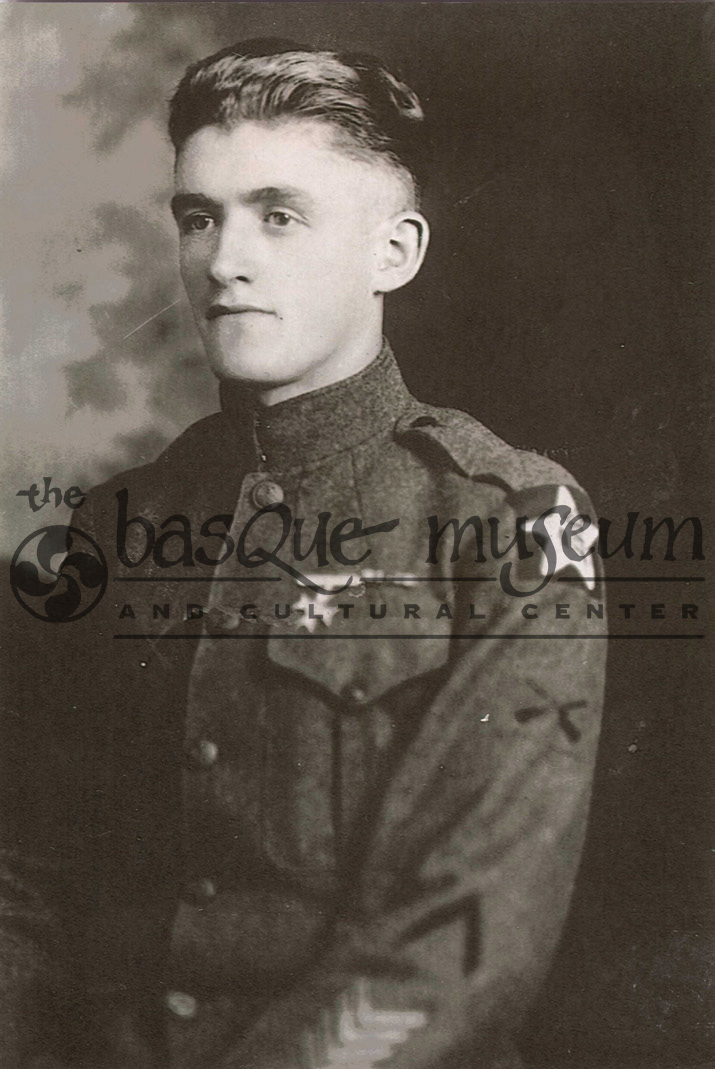 Jean Pierre Echegon
Jean Pierre Echegon
Born in Ordiarp, (Soule) Xiberoa province, France, in 1896, Jean Pierre Etchegoyen immigrated to the US in 1912. He worked with his father in Utah and Idaho on cattle and sheep ranches. In 1917, twelve days after the start of World War I, Jean joined the US Marine Corps and was sent to France. He fought on the front lines including the battle of the Meuse-Argonne.
Following the war, Jean served in the Occupation Army and was a guard on the Rhine River. He was honorably discharged on August 13, 1919. Jean officially became a US citizen in 1933 where the courts changed the spelling of his last name from Etchegoyen to Echegon.
Jean worked for the Western Pacific Railroad for over 30 years. As a locomotive engineer, he contributed to World War II efforts by “driving the trains that carried soldiers and supplies back and forth across the country.” Jean was a charter member of the Elko Veterans of Foreign Wars and served on the Draft Board during World War II.
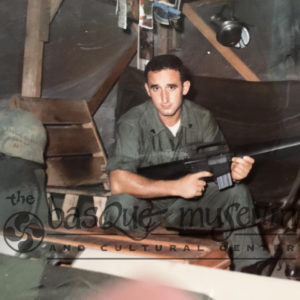 Jose Mari Beristain
Jose Mari Beristain
Jose Mari Beristain was born in the Basque Country, but immigrated to the US in 1957 at the age of twelve to join his father who was already working here. Drafted right out of high school, Jose Mari served in the Marines from 1966-1968. During this time he was deployed to Vietnam and attained the rank of sergeant E5.
“I was in the 1st Battalion, 7th Marines and we moved throughout the northern provinces… I was in a few ambushes and I had a few close calls… but I made it out of there alive.”
He brought photos of the Basque Country with him to Vietnam and wrote on his helmet “Euskaldunak danak bat” which means “all Basques are one”.
 Felix Francois Ordoquihandy
Felix Francois Ordoquihandy
Felix Francois Ordoquihandy served as a corporal in the Marine Corps, 1st Division, Fleet Marine Force, during World War II. He was born in 1926 in San Franscisco, California to parents Jean Ordoquihandy and Martha Mini. Felix was reported as “Missing in Action” on July 17, 1945 while stationed on Okinawa Island. He is memorialized in the National Memorial Cemetery of the Pacific in Honolulu, Hawaii.
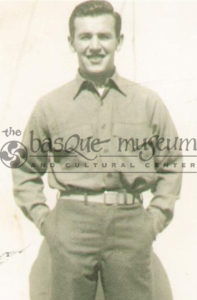 Albert “Al” Pagoaga
Albert “Al” Pagoaga
Albert “Al” Pagoaga was born in Boise, Idaho in 1925. After graduating high school, Al enlisted in the Marine Corp. As Private 1st Class Albert Pagoaga was assigned to Company E, 2nd Battalion, 27th Marine Regiment, 5th Marine Division. He entered combat in World War II in Iwo Jima, a battle lasting from February 19 to March 26, 1945. On March 10, thinking their area was secure, Al and his buddies sat to have lunch on the island. “Out of nowhere a mortar shell was lobbed into their foxhole.” The blast killed Al’s friends and left him critically wounded. He lost his left leg above the knee, his right leg had a compound fracture, and his upper body was cut up by shrapnel. In April 1945, after staying in a hospital in Guam, he was sent to the Mare Island Naval Hospital (California), where he finished recovering from his injuries. He was awarded the Purple Heart Medal.
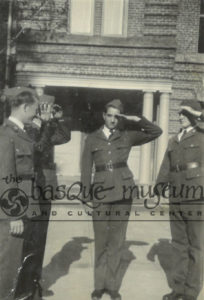 Anthony Yturri
Anthony Yturri
Anthony “Tony” Yturri, originally from Jordan Valley, Oregon, was drafted into service in March 1942. He served as captain in the US Army Air Force, Counter Intelligence Corps and Judge Advocate’s General Corps during World War II. He was sent to Sheppard Field in Texas, with the rank of corporal. In 1943, Tony received a commission as 2nd lieutenant and sent to South America to work in counter espionage. Two years later, he was promoted to 1st lieutenant and graduated at the Judge Advocate General’s Department School. Tony was honorably discharged on March 18, 1946. After the war, Tony entered Oregon politics and served as a state senator for 16 years.
![]()
![]()
![]()
![]() John Monasterio
John Monasterio
John Monasterio was born in Mountain Home, Idaho, in 1911. He attended and graduated from College of Idaho in 1934 and played in the first basketball game between College of Idaho and Northwest Nazarene College. After college he moved back to Mountain Home and taught at the high school from 1934-1942. He joined the Army Air Corp during World War II, declining a commission to serve as a citizen-soldier. John was put in charge of the fitness, social, and psychological support wing of B-26 bomber personnel fighting in Europe. He conducted exercise programs, published a base newsletter, created recreational clubs for off-duty servicemen, and worked with chaplains helping men mange the stresses of combat. He was honorably discharged on December 6, 1945 attaining the rank of staff sergeant with the 482nd Air Force Service Group, 9th Air Force. John was awarded the Bronze Star, Victory Medal, and the European-African-Middle East Service Medal. He returned to Mountain Home after the war and continued teaching until his retirement.![]()
![]() Mitchell and Mitch Cobeaga
Mitchell and Mitch Cobeaga![]()
![]() Mitchell Cobeaga was born in 1917. His parents immigrated to Lovelock, Nevada from Spain to herd sheep. In 1938 Mitchell joined the Army Air Corps and became a B-17 bomber pilot stationed at Hickam Field near Pearl Harbor in 1941. A few months later, in April of 1942, his son, J. Mitchell “Mitch” was born. Mitchell continued flying and conducting bombing raids throughout World War II. He was awarded the Distinguished Flying Cross and the Bronze Star. He was honorably discharged from the military in 1947. Mitchell was recalled in 1949 to serve in the Korean War. During that service he, “served in the Strategic Air Command flying the B-50 bomber, stationed in England on nuclear alert.”
Mitchell Cobeaga was born in 1917. His parents immigrated to Lovelock, Nevada from Spain to herd sheep. In 1938 Mitchell joined the Army Air Corps and became a B-17 bomber pilot stationed at Hickam Field near Pearl Harbor in 1941. A few months later, in April of 1942, his son, J. Mitchell “Mitch” was born. Mitchell continued flying and conducting bombing raids throughout World War II. He was awarded the Distinguished Flying Cross and the Bronze Star. He was honorably discharged from the military in 1947. Mitchell was recalled in 1949 to serve in the Korean War. During that service he, “served in the Strategic Air Command flying the B-50 bomber, stationed in England on nuclear alert.”
Mitch decided to follow his father and graduated from the Air Force Academy (Colorado) in 1964. He trained to fly F-4s in the Vietnam War and began his tour in Thailand in 1967. His father was stationed in California but received orders to move the 22nd Bomb Wing to Vietnam, taking over the B-52 effort there. Because Mitch was Mitchell’s “sole son” he had to get a waiver to be deployed at the same time as his father. Both Mitchell and Mitch thought it was “neat” – Mitch’s mother did not. During the war, Mitchell flew missions from Guam over South Vietnam while Mitch was flying missions from Thailand over North Vietnam and Laos. Mitch later recalled “we had no communication. I think I talked to him once one the phone the entire time I was there.” Mitchell retired from the Air Force as a colonel and moved to Las Vegas. Mitch too moved to Las Vegas after his service and practiced law.
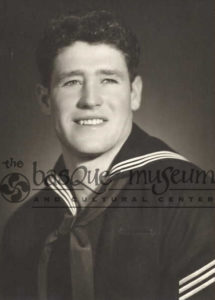 John Dobaran
John Dobaran
John Dobaran served in the Navy from January 1951 to November 1954. Stationed in Bayonne, New Jersey, he was trained as a diver in salvage operations. He achieved a First Class Diver certification and supervised dives and chamber treatments. He then was moved to the Pacific Torpedo Station in Keyport, Washington. John’s unit was tasked with the recovery of torpedoes fired during the testing of propulsion and guidance systems. John was later stationed on board a seaplane tender, the USS Pine Island. In 1954 he was sent out on one of the ship’s WestPac deployments. John kept active in playing basketball while in the Navy, playing while stationed at Keyport Naval Base, they were the Bremerton City Champions in 1952, and the runner up for the Navy playoffs.
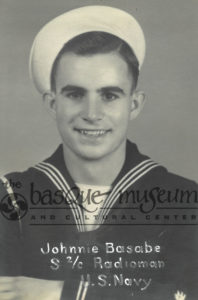 John “Johnnie” Basabe
John “Johnnie” Basabe
John “Johnnie” Basabe of Emmett, Idaho, served in the Navy during World War II as radio, seaman 2nd class. He left high school his junior year, forged his mother’s signature, and enlisted. Johnnie was assigned to the battleship, the USS Idaho (BB-42), and was involved in six battles in the Pacific theater: Layte Gulf, Tinnian, Okinawa, Iwo Jima, the Marians, and Saipan – each earning him a battle star. The Battle of Layte Gulf is where General MacArthur famously stated he “would return” and take back the island. Johnnie was in Tokyo for the surrender of Japan. He was honorably discharged on December 12, 1945. John later went on to manage the livestock operations for the J. R. Simplot Company in Idaho.
 Faustino “Frosty” Alzola
Faustino “Frosty” Alzola
Frosty Alzola was born in 1918 and served in the US Army during World War II. Frosty was able to defer the draft twice because he worked for a ranch in Nevada running 2,000 cattle out of Battle Mountain. On the third attempt to draft him, Frosty became the first man drafted out of Lander County because his last name started with an “A.” Joining the Army in 1941, Frosty remained assigned to the 699th Remount of the Quartermaster Corps, until the end of the War. The 699th Remount Quartermaster Corps issued military supplies – including trained horses and mules. To support allied forces in India, the 699th Remount loaded 94 ships with 400 to 500 horses and mules and sailed across the Atlantic, through the Mediterranean Sea and Suez Canal to Burma (now Myanmar). There they were stationed to care and train the animals for war. Their job in India was to pack ammunition and supplies to the frontlines and to bring bodies out. Frosty remembered having to also protect the horses and mules from predators in India, such as tigers and leopards, and even the occasional violent elephant. Frosty’s work over the years at the Alzola ranch helped to prepare him in many ways for his time in the military.
 John L. Beitia
John L. Beitia
John L. Beitia of Emmett, Idaho and the son of immigrant parents, was just 21 years old when he first enlisted in the Army. John spent nearly 3 years with Patton’s 3rd Army in the European Theatre as part of the 2nd Calvary during WWII. He was commander of a tank and was part of the “Ghost Regiment” that would regularly sneak behind the enemy lines. John received a Bronze Star for his service. He returned to Emmett after the war and continued working at the Boise Cascade Lumber Mill working there a total of 41 years at the time of his retirement in 1984.
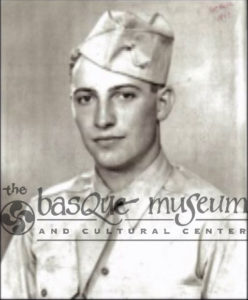 Richard “Dick” Bengoechea
Richard “Dick” Bengoechea
Richard “Dick” Bengoechea was born in Jerome, Idaho in 1925, the eldest of 9 children. Dick’s father, Victor, was an immigrant and they ran sheep in the Jerome/Twin Falls, Idaho area. When Dick was 19, his military deferment ended and he was sent to Fort Knox in Louisville, Kentucky. “When you got to Fort Knox you knew you were in armour then, you weren’t in the infantry. They picked guys from the West and Mid-West…they knew they had some mechanical aptitude because they worked on the farm and that’s the reason they picked them.” After months of traveling through France as part of the 712th Tank Battalion, Dick was attacked on Easter Sunday, April 3, 1945 near Darmstadt, Germany while outside of his tank working on a truck. “I looked up and it (the German plane) was coming just like in the movies. I hollered… here comes one of those s.o.b.s now…and that’s the last thing I remember.” Richard is a Purple Heart Recipient and has been active in military parades and activities in the Boise, Idaho area for many years.
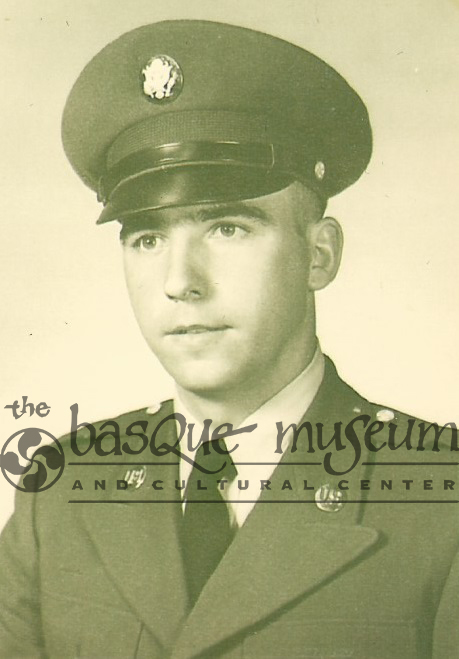 Sabino Goitiandia
Sabino Goitiandia
Sabino Goitiandia was drafted as a non-citizen in the Army for the Korean War. He worked in Boise, Idaho, & was called into service. He trained for six months in Fort Ord, California in 1958. From there he went into the Army Infantry, traveling through Hawaii and Tokyo before arriving at the Army base south of Seoul. He served overseas for 13 months as a cook. Not encountering any other Basques, Sabino saw this time as an opportunity to practice his English. He left the Army in January of 1960 and joined the Army National Guard for four additional years. Sabino became a US citizen in 1960, after five years of residency.
World War II saw creation of women’s auxiliary corps in the different military branches. These auxiliaries were created to get men away from the desk and onto the battlefield. Responsibilities of the women ranged depending on the military branch, but could include being clerks, drivers, secretaries, translators, other administrative positions, radio operators, auto mechanics, telegraph operators, laundry operators, stenographers, parachute riggers, and photographers. The different auxiliaries were the Women’s Army Corp (WAC), Women Accepted for Voluntary Emergency Service (WAVES) for the Navy, the Marine Corps Women’s Reserve, and the Women in the Air Force program (WAF) established in 1948. Unlike the women’s auxiliaries in other branches of the military, women in WAC could be deployed anywhere, including the battlefield.
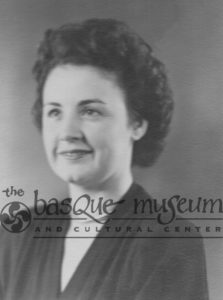
 Irene Dolores Bicandi Anderson and Consuelo “Connie” Bicandi Franks
Irene Dolores Bicandi Anderson and Consuelo “Connie” Bicandi Franks
Irene Dolores Bicandi was from Emmett, Idaho. After graduating from high school, she worked in a general store until 1944. Her boss, who was unable to serve in the military, encouraged her to join the service and promised to give Irene her job back when she returned. Irene was nervous but when her cousin, Connie Bicandi asked her to enlist along with her, Irene did. Both women joined the Navy WAVES and both tested into the bookkeeping-training program. They spent time stationed in New York, Georgia, and San Francisco. When they were discharged in 1946, Irene returned to work at the store in Emmett. Soon after she met and married Allen “Andy” Anderson. Connie also returned to Idaho after the War and married Ernest Pete Franks in Caldwell, in 1947.
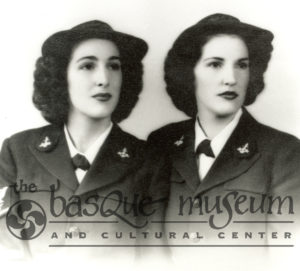 Mingo Sisters
Mingo Sisters
Benita “Bene” and Virginia Mingo both joined the Navy WAVES in 1944. While they requested to be stationed together, Bene was sent to Washington D.C. and Virginia to Washington State. They both served as petty officers third class. Bene was honorably discharged on February 15, 1946, with the rank of Store Keeper third class. She met Francis “Frank” Schaffner at a dance in Washington D.C. and they married in Boise, Idaho, on February 23, 1946. Virginia returned to Boise after her honorable discharge in 1946. She married Harold “Bill” Shelley in February 1947.
Thousands served as nurses in both World War I and II. In 1947, both the Army Nurse Corps and Navy Nurse Corps allowed nurses to be commissioned as officers in the Regular Army and Navy, giving them full rights, privileges, and pay according to their rank. The Army Air Force also had specially trained nurses called flight nurses. They were trained to help transport patients from the frontline hospitals to full medical facilities.
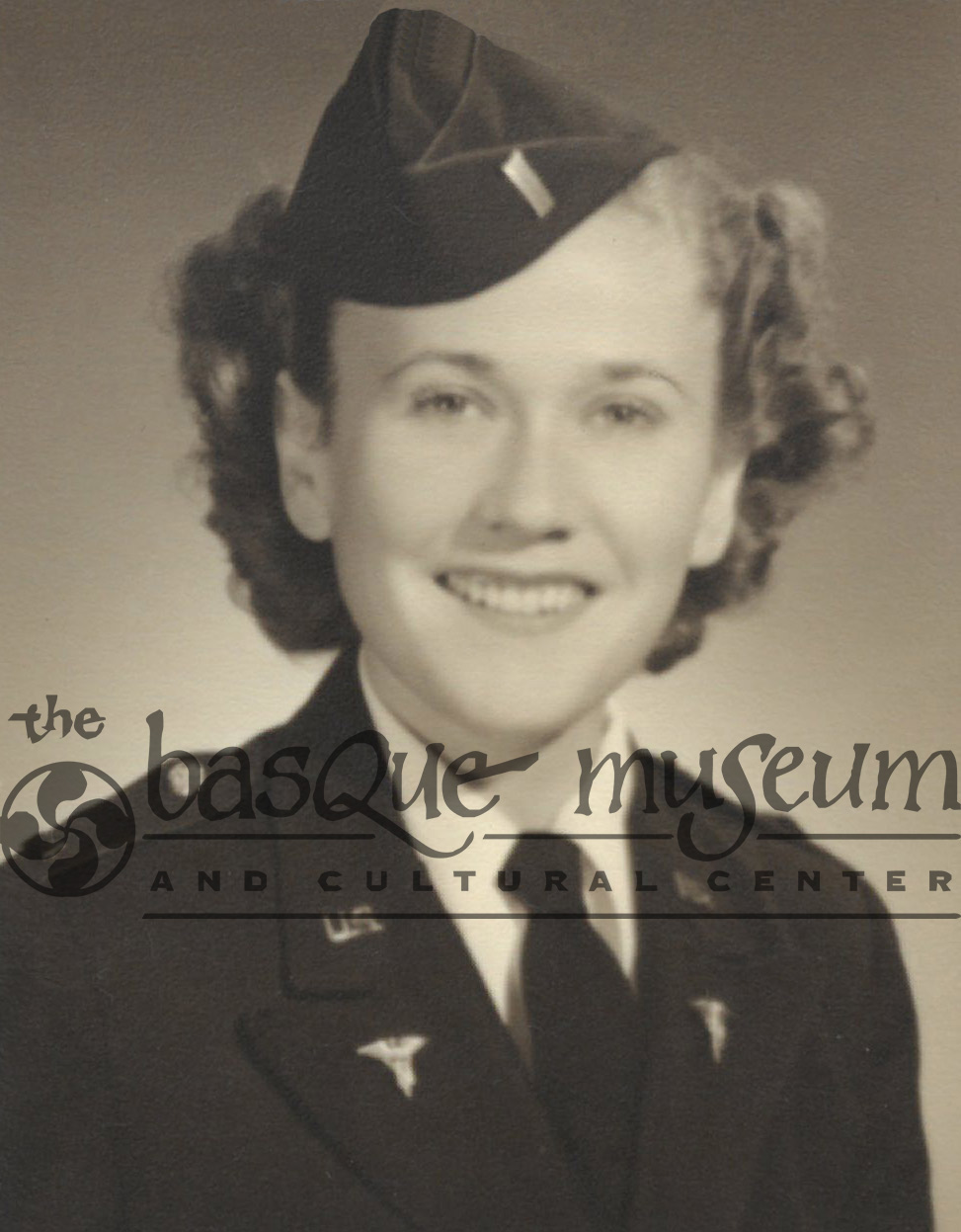 Maria Rementeria
Maria Rementeria
Maria Rementeria was born in 1917 and graduated from Boise High School in Boise, Idaho. She attended the St. Alphonsus School of Nursing and the US Army School of Nursing. During World War II, Maria was stationed at jungle hosptials in the South Pacific. After the war, Maria attained an advanced degree at Sacred Heart University in San Francisco and a Masters in Nursing from Columbia University. From there Maria enlisted in the US Department of Hospitals and Health Services. She retired from the Navy as a full colonel and director of Public Hospitals Health Services for the US.
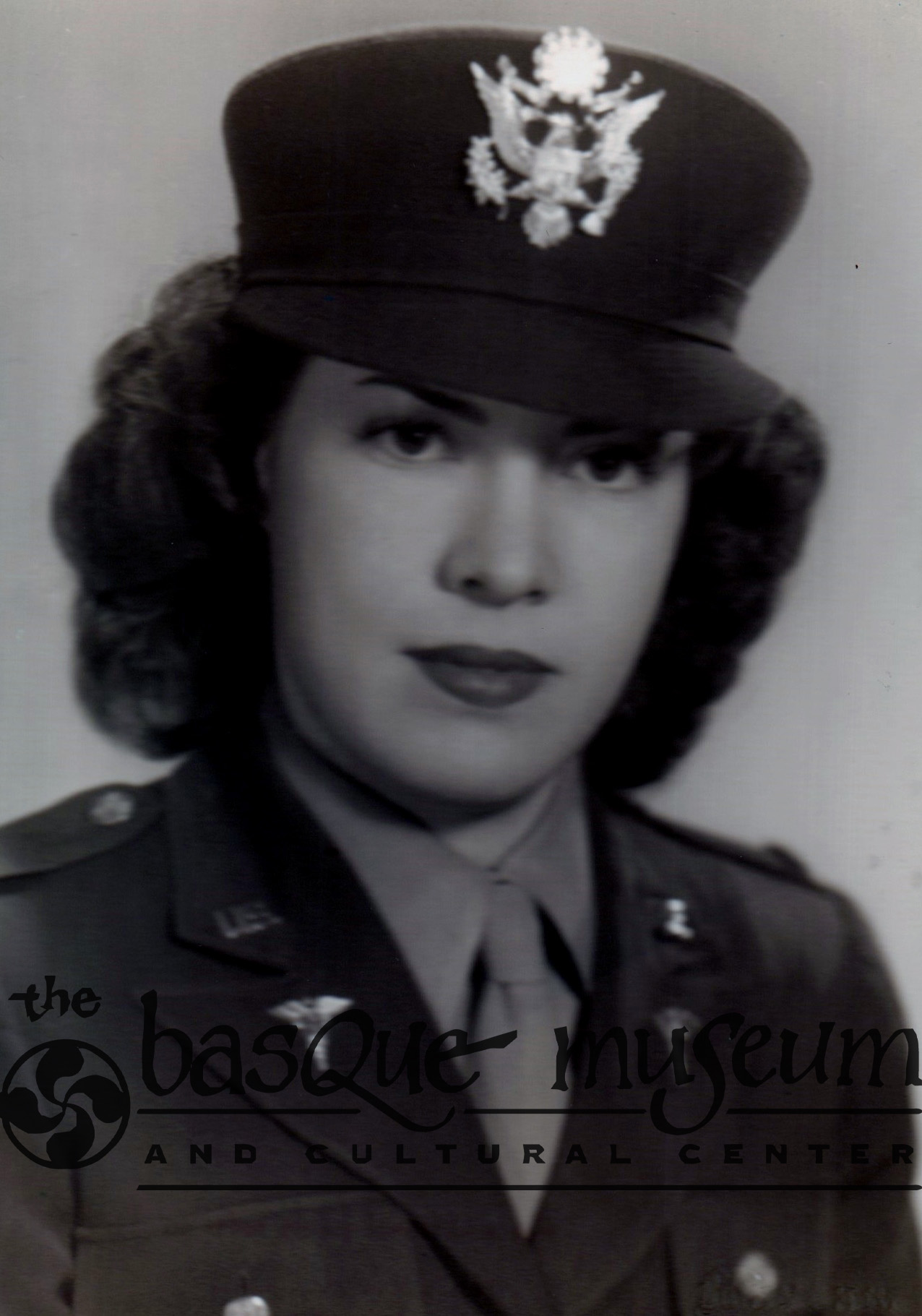 Regina Bastida Aldecoa
Regina Bastida Aldecoa
Born in Boise, Idaho in 1922 at St. Alphonsus Hospital, Regina Bastida later went on to graduate from the St. Alphonsus Nursing School. After encouragement from a few doctors, Regina decided to continue her education in Cleveland, Ohio, and graduated specializing in anesthesiology. When she returned to Boise, she “had a strong desire to go into the service because there was a great need and call,” however the nuns disagreed because the of the city’s need for more than just two anesthesiologists for three hospitals. Regina remembers “It was difficult to say no to them, but I wanted to go to the service so badly.” She became an Army nurse, serving during World War II. “My Army experience was tremendous…I enjoyed all the people, enjoyed the patients, and certainly learned much while I was stationed in California.” After the war, Regina and her husband, Fermin Aldecoa, established a scholarship at the Boise State University School of Nursing. She was recognized by the Catholic Bishop of the Diocese of Boise for outstanding nursing to the community for many hours of volunteer service and a commitment to people in need of health assistance. Regina’s career in nursing spanned over 40 years, 25 of which was spent at St. Luke’s Hospital in Boise, Idaho.
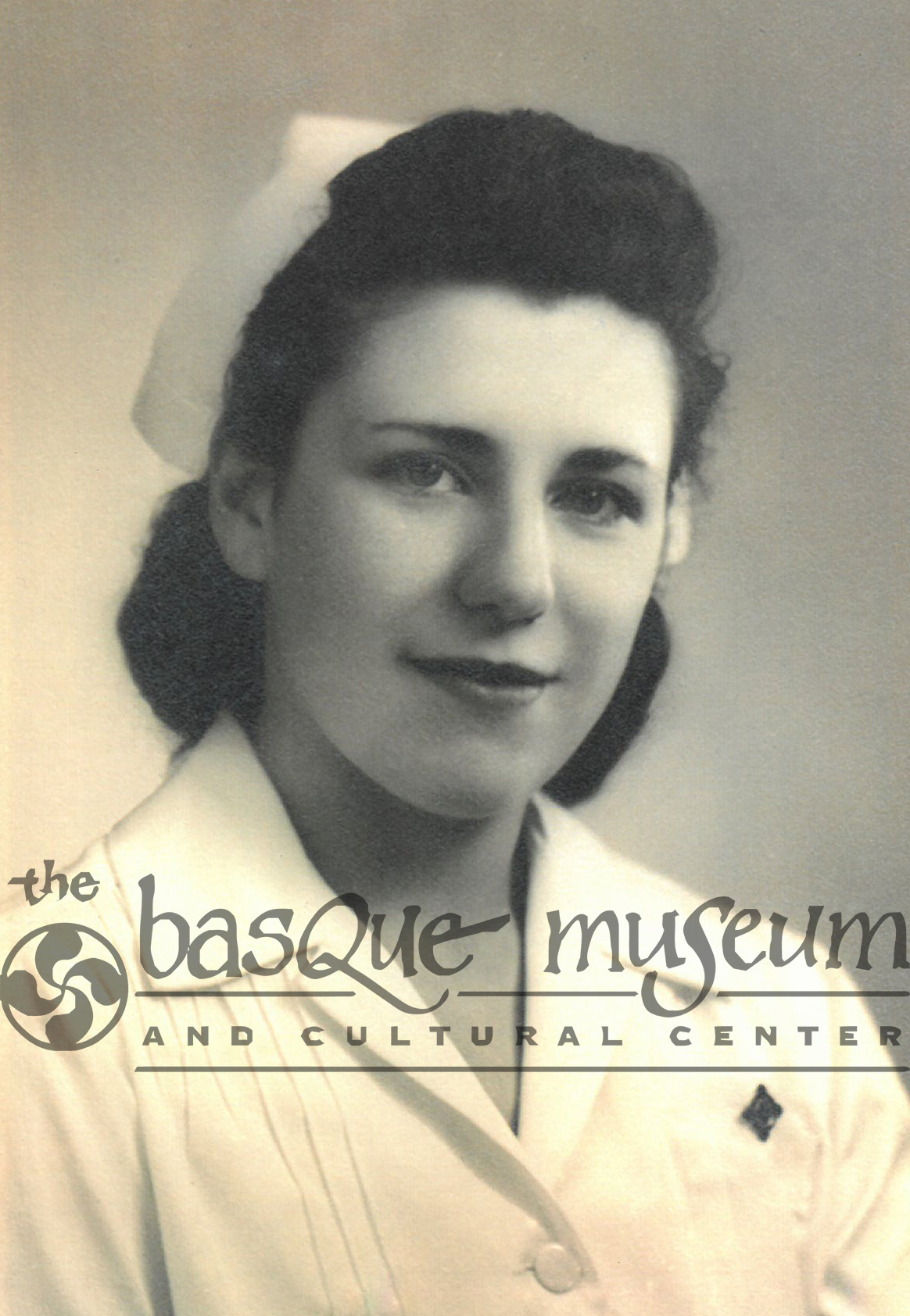 Lydia Dobaran Mendiola
Lydia Dobaran Mendiola
Lydia Dobaran Mendiola was born in Glenns Ferry, Idaho, and completed nurse training at St. Alphonsus in Boise. She joined the Army in 1945 and served until July of 1948. She went overseas to the Philippines for nine months and completed her service in San Francisco, California. Most of her patients were post-acute (or rehabilitation patients). Lydia was also active as a first lieutenant in the Army starting in January 1951, and was honorably discharged in October of the same year. Lydia worked a as registered nurse for over 40 years in both Boise and Mountain Home, Idaho.
While women could enlist in the different US military branches in the late 1940s, it was not until recently that women were able to carry out combat service. The roles of women in the military continues to grow and women of Basque lineage are contributing to the story of Basques in the US military.
The sacrifices of war were felt beyond the battlefield. During World War II, a group of undrafted Basques decided to play their own role in the military. The “Boise Home Guard” or the Boise Company, Ada County Volunteers, was created as a civil defense regiment consisting of all Basques from the Boise, Idaho area. For those who could not enlist, this group of dedicated Basque-Americans would meet and train to prepare if the war extended stateside.

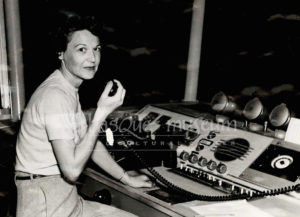 Delphine Aldecoa
Delphine Aldecoa
Delphine was at the University of Idaho when Pearl Harbor was bombed. After graduating in 1943, Delphine returned to Boise, Idaho and was recruited for a position in air traffic control. Only 20 years old at the time, she had to wait a year before her training, but worked in the Gowen Field base school office until she was old enough. She talked her sister, Bene, into applying for the same job and after training, the two were stationed in Great Falls, Montana. After the war, when the other women had been sent home, Delphine wanted to continue as an air traffic controller and became the 2nd woman in the United States to run an air tower. Delphine worked in Great Falls, Seattle, Spokane and her last position was as the Chief Controller, in charge of the facility, in Hillsboro, Oregon just outside of Portland. She retired after 32 years working as an air traffic controller.
Arguably the greatest contribution made to the war effort was the service of young men, and no one felt this hardship more than their mothers. For many families a son or two may be deployed, but for larger families, some had 4 or more sons in the military at once.
The Mentaberry Family
A large ranching family, the Mentaberry name is well-known in the Winnemucca, Nevada, area. Of the six Mentaberry brothers, four of them enlisted in the military. All were born in Winnemucca between 1921 and 1932. Fausto “Foe” enlisted in the Army serving in the Philippines and Japan during World War II. Henry “Hank” volunteered for the Marine Corps at the time of World War II serving for 4 years. George Batiste “Patch” was inducted into the Army in 1951 and was shipped to Korea to fight on the front lines. David Pete “Lep” enlisted in the Air Force in 1952, and was sent out to the Far East in 1953, working closely with the Secret Service Agency. Because his mother was not a US citizen he was dropped from the Secret Service section. All four boys returned home to Nevada after their service.
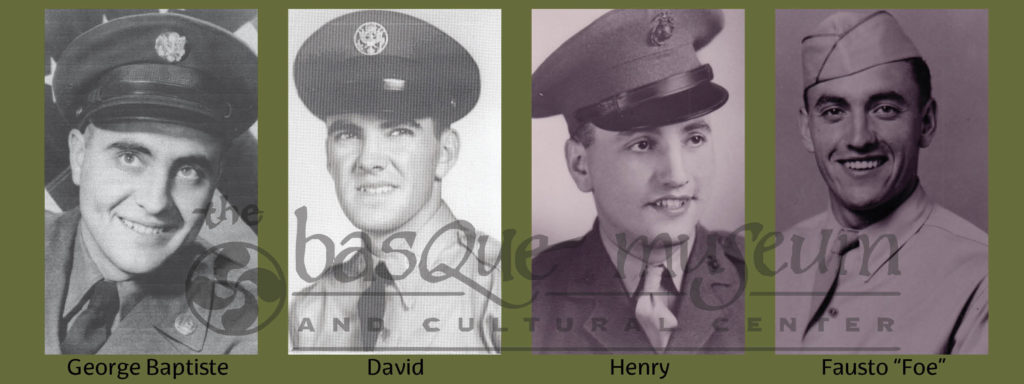
The Elordi Family
The Elordi family of Jordan Valley, Oregon had 12 children total, seven boys, five who were of age to serve during World War II. Joe, John, Thenon “Fat,” and Frank Elordi all served in the US Navy. Floyd “Shadow” Elordi served in the US Army. All five boys were deployed separately to the Pacific. Shadow was drafted in 1944 and entered the 184th Infantry Regiment. He landed on Okinawa Island on April 1, 1945 under fierce Japanese opposition, losing 40-50 men a day. By the War’s end, all five Elordi boys made it home. Shadow would go on to fight in the Korean War and again returned home safely.
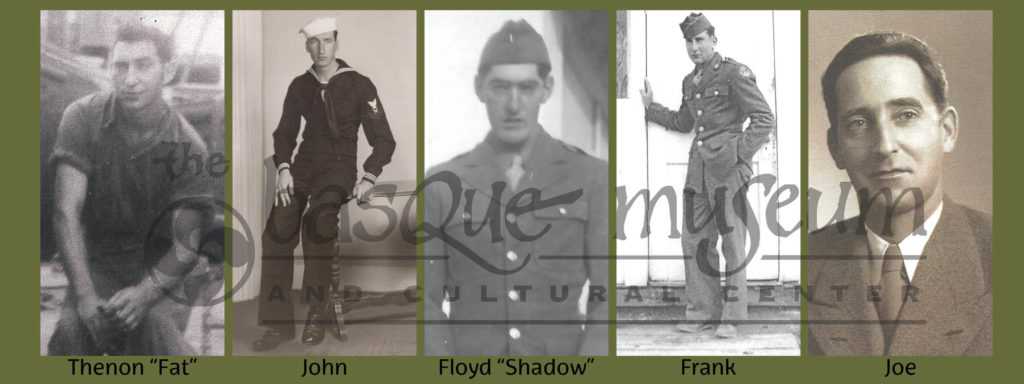
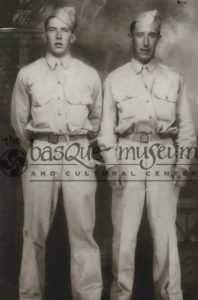
 The Gastelecutto Family
The Gastelecutto Family
The Gastelecutto family of Nevada had four sons overseas during World War II. John, Louie, Jess, and Frank all enlisted in the US Army. Corporal Frank Gastelecutto was stationed in Germany. Both John and Louie were stationed in France as part of the 301st Glider/Paratroop Infantry Division. John achieved the rank of sergeant. Private Jess Joseph Gastelecutto fought with the 11th Infantry Regiment, 29th Infantry Division. Jess and his regiment landed on D-Day at Omaha Beach in Normandy and fought in Saint Lo and Brest (France) as well as Birgden-Kreuzrath (Germany). Jess was killed in action at Birgden-Kreuzrath on October 7, 1944, two days before his 20th birthday. He was awarded the Purple Heart. Upon completion of their service, John, Louie, and Frank returned home.
The Chacartegui-Sillonis Family
The Chacartegui-Sillonis family of Mountain Home, Idaho had seven children. Six sons and one daughter, the first born, Juan died as an infant. In 1942 all five boys enlisted in the military. Julio and John Louis “Chuck” joined the Navy and trained at Treasure Island Naval Station in San Francisco, California. Julio was deployed to Guam and Chuck was sent to the South Pacific. Richard Pablo “Richie” and Alfonso joined the Army. Richie was deployed to Germany and assigned to the 11th Tank Battalion “The Tigers.”Alfonso was assigned to the Sixth Army, 19th Infantry Regiment of the 24th Infantry Division and deployed to New Guinea and the island of Leyte in the Philippines. Staff/Technical Sergeant Alfonso Sillonis was killed in action in October 1944. He was awarded the Silver Star and Purple Heart. The youngest brother, Robert “Rob” was inducted into the Army Air Force just before his 21st birthday in 1942. He was deployed to the South Pacific and served in Saipan. Within the Army Air Force, Rob was an Airplane Instructor Specialist and earned the rank of staff sergeant. During his service in World War II he was awarded the AAF Tech Badge, Marksman 03 Rifle, American Theatre Service Medal, Victory Medal, Western Pacific Campaign Medal, Asiatic Pacific Service Medal and a Good Conduct Medal. Julio and Richie were honorably discharged in 1945 and returned to life in Idaho. A year later, Chuck and Rob were also honorably discharged. Chuck returned to Mountain Home, while Rob joined the Army Corps of Engineers and worked on various dam projects until his retirement in 1967.
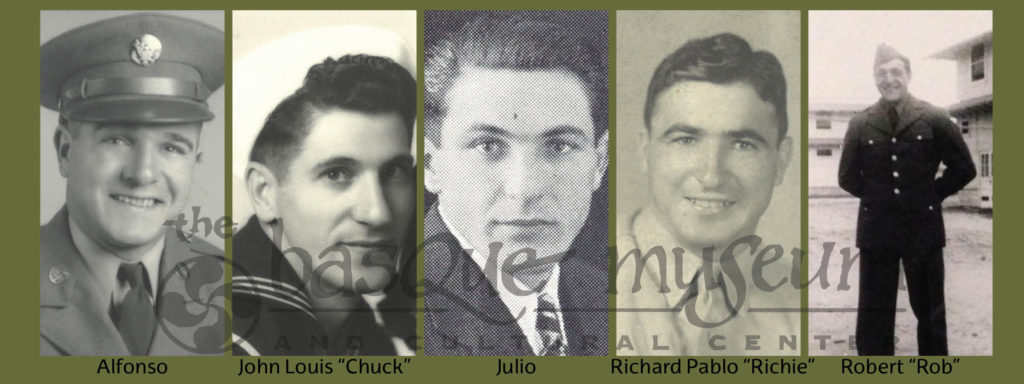
Many soldiers who fought for the US lost their lives in the pursuit of freedom for others. Countless were injured, some were (and some are still) considered missing. Families and loved ones at home carry the pain of the ultimate sacrifice soldiers have made for America.
 Joaquin Sarasqueta
Joaquin Sarasqueta
First Lieutenant Joaquin “Joe” Sarasqueta was born in Shoshone, Idaho, and moved to California as a child. He was a bombardier aboard a B-17 with the 8th Air Force during World War II. Because of his bombardier position in the front of the plane, he was able to take a few photos with his Brownie camera as he and his crew traveled to and from targets. He also kept a diary of every mission but did not go into significant details; in the event of his death, he wanted the diary to get past wartime censors and back to his sister. The diary entries include accounts of watching planes get shot down and counting the parachutes that opened on the way down. On June 20, 1944, while on a mission over Hamburg, Germany, Joe was struck in the face with flak just after releasing his plane’s bomb load. He recounted the incident in his diary: “[the] flak came thru [sic] the nose and went out a side window, it sounded like a fast car passing you on the highway. As it went by it grazed my cheek. I was afraid to feel my face, wondering how badly I had been hit…I could see blood on the glove.” Joe was awarded a Purple Heart for his injury. The award and the hole left in his cap are the physical reminders that of how close Joe had come to being killed in action. Throughout the War, Joe flew over 30 missions and received, in addition to his Purple Heart, the Distinguished Flying Cross, the Air Medal, and three Oak Leaf Clusters. During training, Joe met fellow Basque Manuel Aldecoa from Boise. The two parted ways after training, but while on a short break in London, Joe visited Madam Tussaud’s Wax Museum and signed the guestbook. Scanning through the names written before his own, Joe saw Manuel’s name. As he recounted the story to family shortly before his death in 1995, he wondered aloud about Manuel and if he made it home. He never learned that Manuel had been killed in action.
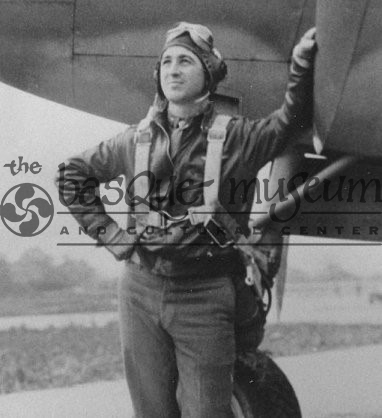 Manuel Aldecoa
Manuel Aldecoa
Manuel Aldecoa was born in Boise, Idaho in 1917. He graduated from Boise High and attended the University of Idaho for two years before enlisting in the Army Air Corps. He initially received training as a radio operator at Scott Field, Illinois, and was stationed at Fort George Wright, in Spokane, Washington. After two years he was accepted for aviation cadet training completing primary training at Santa Ana, California and basic training at Santa Maria, California. He was commissioned a 2nd lieutenant at Williams Field, in Arizona in April of 1943. He was then stationed at Olympia Air Base in Washington before being sent to England as a P-38 Lockheed Lightning pilot. Manuel was part of the first group to fly the P-38s out of England. He flew escort protection for heavy bombers in raids on Wilhelmshaven, Munster, and Bremen. Manuel was reported as missing when he did not return from a mission over France. He had entered combat with a highly decorated German ace, Johannes Seifert. Both were shot down, neither survived the encounter. The German government confirmed he was killed in action on Thanksgiving Day, November 25, 1943, the day before his 26th birthday. Manuel was awarded the Purple Heart and the Air Medal posthumously.
 Joseph Landa
Joseph Landa
Corporal Joseph Landa was born in Ibarranguelua and immigrated to the US with his parents at the age of five. He graduated from Marsing High School in Marsing, Idaho. At the age of 21 he entered the US Army on November 28, 1950. He was deployed to Korea and was reported as missing in action on November 6, 1951. He was later reported as being killed in action.

James Corta
Brothers Simon and James Corta both enlisted in the Army during World War II. Both men found themselves in Italy at the same time. Simon tried to get James transferred to his outfit but was denied. They wouldn’t move James because he was a machine gunner. Three days later, James was killed. The Germans had thrown a hand grenade into his machine gun nest and killed all in their bunker. Simon Corta was assigned to 41st fighter support outfit taking care of different kinds of airplanes. He spent time in Africa, Sicily, and Italy and was near Mt. Vesuvius when it erupted. Simon was in Italy when the war ended. Those who had high points (earned for time spent in combat) got to go home first and Simon was in that group. Due to bad weather, however, his group was forced to take a ship back to the states and they arrived well after the “low point guys.” Simon was honorably discharged on October 16, 1945.
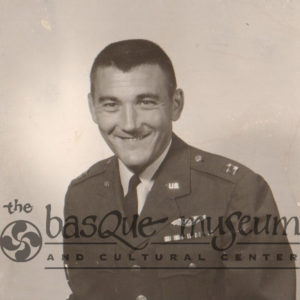 Joseph Ygnacio Echanis
Joseph Ygnacio Echanis
Major Joseph Ygnacio Echanis was from Ontario, Oregon. He was a member of the US Air Force during the Vietnam War. Joseph’s aircraft crashed in January of 1975, and he was never recovered. He is recorded as missing in action.
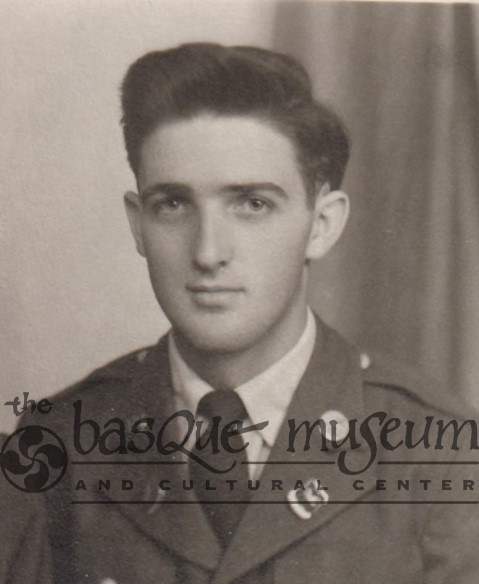
Joseph “Joe” Barroetabena
Joseph “Joe” Barroetabena of Emmett, Idaho, enlisted in the Army on January 16, 1943. He achieved the rank of staff sergeant during World War II. During the War, Joe was taken as prisoner of war in Germany for three years. When he was released he was honorably discharged from the Army and awarded the Purple Heart.
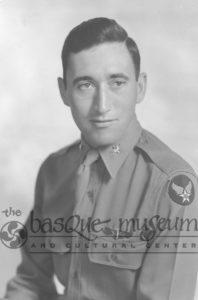 David Rementeria
David Rementeria
Lieutenant David Rementeria was a graduate of Boise High School who continued his education attending Boise Junior College and the University of Oregon School of Law. He practiced law for a year before entering the service. David was a bombardier with the Army Air Corps and had participated in 17 missions before being killed in action. On March 24, 1944, the B-17 carrying David and the rest of the crew crashed upon takeoff from an airfield at RAF Chelveston in England.
 Richard Aguirre
Richard Aguirre
Richard Aguirre was a senior at the University of Washington when he and several friends joined the Army Air Corps, soon after the attack on Pearl Harbor. He achieved the rank of 2nd lieutenant and was navigator on a B-17 named Kai-O-Keleiwa, the guardian of heaven. Richard and his crew members were shot down on May 21, 1943. The bombardier was the only survivor.
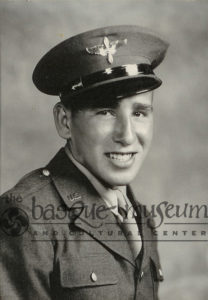 Louis Dobaran
Louis Dobaran
Louis Dobaran was born on October 29, 1924 in Glenns Ferry, Idaho. After graduating from high school, he enlisted in the Army Air Force. Louis was a flight engineer on B-17s and in 1944 he was shot down on a mission over Munich, Germany. His plane crashed near the Swiss border. All but one of the crew survived. The remaining crew members made their way to the Swiss border where they were taken into custody by the Swiss and interned until May of 1945, the end of the war in Europe. He was honorably discharged from the Army Air Force after his release on October 29, 1945.